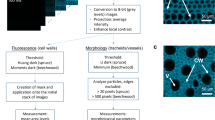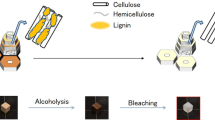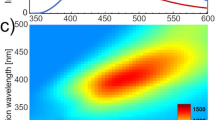Abstract
The fluorescence of furfurylated wood was studied. Furfurylation of wood introduced fluorescent curing products into the cell walls. Fluorescent products were also found in the lumina if high loadings were used and/or if the wood contained cells with small radii. More intense fluorescence was obtained from lignin-rich parts of the compound cell wall (i.e., the middle lamella and the cell corners) than from the secondary cell wall if the wood was impregnated using furfuryl alcohol (FA), while impregnation using small poly(FA) oligomers showed no or only minor differences between different regions. The study also showed that when higher amounts of catalyst were added to the impregnation liquid, a red-shift in the fluorescence from the furfurylated wood was seen, corresponding to an increased conjugation length of conjugated poly(FA) formed within the wood cell wall. Longer conjugation length than within the cell wall was observed for the poly(FA) formed within the lumina. This indicates that the cell wall polymers restrict poly(FA) formation.








Similar content being viewed by others
References
Andersen C, Bro R (2003) Practical aspects of PARAFAC modelling of fluorescence excitation-emission data. J Chemometr 17:200–215
Andersson CA, Bro R (2000) The N-way toolbox for MATLAB. Chemometr Intell Lab Syst 52:1–4
Baunsgaard D (2000) Analysis of color impurities in sugar processing using fluorescence spectroscopy and chemometrics. Ph.D. thesis, Department of Dairy and Food Science, The Royal Veterinary and Agricultural University, Copenhagen
Bertarione S, Bonino F, Cesano F, Damin A, Scarano D, Zecchina A (2008) Furfuryl alcohol polymerisation in H-Y confined spaces: reaction mechanism and structure of carbocationic intermediates. J Phys Chem B 112:2580–2589
Choura M, Belgacem NM, Gandini A (1996) Acid-catalyzed polycondensation of furfuryl alcohol: mechanisms of chromophore formation and cross-linking. Macromolecules 29:3839–3850
Goldstein IS (1955) The impregnation of wood to impart resistance to alkali and acid. For Prod J 5:265–267
Goldstein IS, Dreher WA (1960) Stable furfuryl alcohol impregnation solutions. Ind Eng Chem 52:57–58
Hadi SY, Westin M (2005) Resistance of furfurylated wood to termite attack. For Prod J 55:85–92
Jansson E, Jha PC, Ågren H (2007) Chain length dependence of singlet and triplet excited states of oligofluorenes: A density functional study. Chem Phys 336:91–98
Lande S, Westin M, Schneider MH (2004a) Eco-efficient wood protection—furfurylated wood as alternative to traditional wood preservation. Ind Eng Chem 15:529–540
Lande S, Eikenes M, Westin M (2004b) Chemistry and ecotoxicology of furfurylated wood. Scand J For Res 19:1–8
Lande S, Westin M, Schneider MH (2004c) Properties of furfurylated wood. Scand J For Res 19:22–30
Nordstierna L, Lande S, Westin M, Karlsson O, Furó I (2008) Towards novel wood-based materials: chemical bonds between lignin-like model molecules and poly-(furfuryl alcohol) studied by NMR. Holzforschung 62:709–713
Olmstead JA, Gray DG (1997) Fluorescence spectroscopy of cellulose. Lignin and mechanical pulps: a review. J Pulp Pap Sci 23:J571–J581
Rinnan Å (2004) Application of PARAFAC on spectral data. Ph.D. thesis, Department of Food Science, The Royal Veterinary and Agricultural University, Copenhagen
Schneider MH (1995) New cell wall lumen wood polymer composites. Wood Sci Technol 29:121–127
Stamm AJ (1964) Dimensional stabilization. Wood and cellulose science. The Ronald Press Company, New York, pp 312–342
Venås TM, Thygesen LG, Barsberg S (2006) Chemical reactions involved in furfurylation of solid wood—an investigation by ATR-IR spectroscopy. In: Proceedings from the 37th annual conference of the International Research Group on Wood Protection, Tromsø, pp 1–10
Xue C, Luo F-T (2004) Rapid synthesis of oligo(p-phenyleneethynylene)s via iterative convergent approach. Tetrahedron 60:6285–6294
Acknowledgments
L.G. Thygesen and S. Barsberg acknowledge funding from the European Commission (“Furan and lignin based resins as eco-friendly and durable solutions for wood preservation, panel, board and design products”, call FP6-2003-NMP-SME-3).
Author information
Authors and Affiliations
Corresponding author
Rights and permissions
About this article
Cite this article
Thygesen, L.G., Barsberg, S. & Venås, T.M. The fluorescence characteristics of furfurylated wood studied by fluorescence spectroscopy and confocal laser scanning microscopy. Wood Sci Technol 44, 51–65 (2010). https://doi.org/10.1007/s00226-009-0255-4
Received:
Published:
Issue Date:
DOI: https://doi.org/10.1007/s00226-009-0255-4




